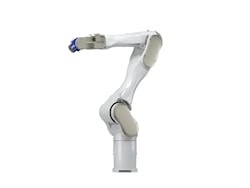Epson’s new six-axis robots bridge divide between industrial robots and cobots
By Bruce Geiselman
Moving with the speed and payload of industrial robots, the six-axis robots in a new Epson Robots series are equipped with technology designed to allow them to work alongside people.
The C-B robots have Epson’s RC700E controller and SafeSense technology, a suite of technologies that allow for safe human-robot interaction without a safety fence through safety-rated speed and position monitoring when combined with a proper risk assessment. According to the company, SafeSense includes standard and advanced safety features that allow for increased productivity and worker protection safety and protects workers by allowing a robot to avoid hitting them by knowing where they are.
The technologies are what allow the robots to fill a unique niche – as what Epson calls industrial collaborative robots, designed to bring the speed of industrial robots to collaborative work cells. They can perform industrial tasks that include tending injection molding machines.
The series, including the The C-B series offers multiple arm configurations with a reach of up to about 4.6 feet. The series includes the C4B, C4LB, C8LB, C8XLB and C12XLB models, are available with multiple arm configurations with a reach of up to about 4.6 feet, and payloads of about 8.8, 13.3, 17.6 and 26.5 pounds.
The robot series’ safety technologies enhance productivity by enabling faster machine interactions for daily operations, potentially reducing the need for physical safety barriers and thus lowering the overall footprint and cost of the automation system. Jim Shimano, Epson product manager, demonstrated how SafeSense might function in a work cell where humans sometimes work near a robot.
“When the person is nowhere near the cell, the robot moves at full speed and moves anywhere it would like within the cell,” he said. “When the person approaches — in this case, he steps on a pressure sensitive mat, but it could also be done by breaking through a light curtain — then, the robot will slow down. As the user approaches, you can still get full travel, but you’ve got limited speed that allows for corrections when the person actually breaks into the field.”
Other signals that will trigger the robot to alter its motions include detection of a person by a laser array or LiDAR (light detection and ranging) technology.
“Now, it’s limiting its travel to the area the person is not,” Shimano said.
Epson Robots previously integrated SafeSense technology with some of its SCARA robots, but this is the first time it has been integrated with a six-axis robot, Shimano said.
Third parties offer solutions similar to SafeSense as an add-on, but Epson decided to offer its own integrated solution to make it easier for customers, so they don’t have to buy a separate safety PLC from a third-party vendor and integrate it with an Epson robot.
“If you buy a robot and safety equipment separately, someone’s got to take responsibility for that integration,” Shimano said. “You’ve got to get it verified and checked to make sure that it meets the safety requirements. Epson’s done that work for you.”
While it incorporates SafetySense into its C-B rbots, Epson does not provide worker-sensing equipment, such as mats and arrays, Shimano said. Those must be added separately.
The C-B robots also include Epson’s advanced Gyroplus vibration reduction technology, which uses a sensor in the robot arm that adjust the motor to dampen vibrations, allowing for fast production speeds and smooth motion control. The technology suppresses inaccurate trajectory and uneven speed to achieve high speed and high precision.
The robots also include battery-less encoders, which reduce the total cost of ownership and downtime for maintenance.
Contact:
Epson Robots, Carson, Calif., 562-290-5910, www.epsonrobots.com
About the Author
Bruce Geiselman
Senior Staff Reporter Bruce Geiselman covers extrusion, blow molding, additive manufacturing, automation and end markets including automotive and packaging. He also writes features, including In Other Words and Problem Solved, for Plastics Machinery & Manufacturing, Plastics Recycling and The Journal of Blow Molding. He has extensive experience in daily and magazine journalism.
